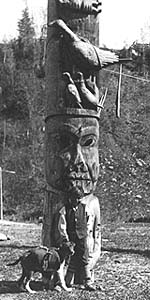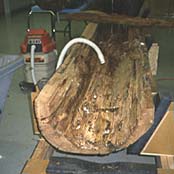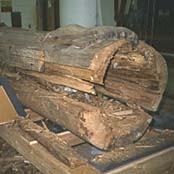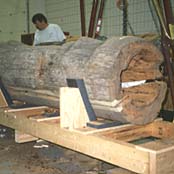Grand Hall tour
 |
Conservation and Restoration |
The pole Gambalch is the most extensive restoration of a totem
pole ever undertaken to preserve the cultural heritage of the West
Coast. The Museum had three of the seven sections of the original
pole. The middle two sections were badly deteriorated when the Museum
acquired them. The normal response to a deteriorated pole has been
to re-carve the whole pole. The Museum decided, however, to preserve
as much of the original as possible. The remaining four sections had
been lost and had to be recarved.
Restoration

|
The replacement parts of the pole were carved by Sam Wesley of
Gitsegukla, Master Carver; Darrell Milton, Carver; and Ron Brown,
Assistant Carver, a descendant of William Brown (Nass).
The lower two sections, "Grouse and Brood" and "Moth",
are among the replacements. As can be seen by comparison with the
photograph taken in 1910 by George T. Emmons, the replacement
Grouse is more stylized than the original, and the features on the
human face of the Moth are less severe on the replacement than on the
original. Note also that Moth has arms on the original pole similar
to the arms that can be seen on the Moth Mask being worn by Thomas
Campbell. Directions to the carver of a replacement section are to
capture the meaning of the original not to replicate it exactly.
|
Photograph: George T. Emmons
CMC 71-5633
|
Conservation
The conservation of the three original sections was undertaken
by a team from the Museum's Conservation and Technical Services
Division, consisting of James Hay, Conservator; Ghislain
Bérubé, Conservator; Charles Hett, Contract Conservator;
and Denis Gauthier, Cabinet Maker. After careful examination and
testing it was determined that the sculpture's interiors were voids,
structurally, and would require internal bracing to support the
weight of the new replacement pieces.
The sculpted face was sawn off of the back to expose the interior,
and all rotten interior material was removed. New pieces of western
red cedar were sawn and custom-fitted to the irregular void, then
glued in place with epoxy. Surfaces on the right side of the pole
that had been lost to rot were similarly filled with new wood, and
sculpted to mirror original features. The new sections were carefully
cut to align with old sections; alignment was secured with dowels and
new surfaces were shaved in line to match the old. Next, new wood was
textured to simulate the old wood and, finally, coloured to match.
The last step was to design and build the enormous metal mount, or
"strongback", and attach all the sections of the pole to it.

|
On this photograph of Winged Person (Gagaimget)
(to the left), you can see the deterioration
behind the face, to the wing, and generally on the back of the
figure. These parts were replaced.
|

|
|
On this photograph of Moth or Winged Person Holding Child
(to the right) you can see the rotten section
behind the face and along the back of the figure. These parts
were replaced, along with the rotten heartwood; the rear
of the wing and face were recarved.
Note also how hooked the nose is. This representation probably
symbolizes a person transforming into a moth, with the nose changing
into a pointed beak. |
|
Photographs: Merle Toole
|
|









